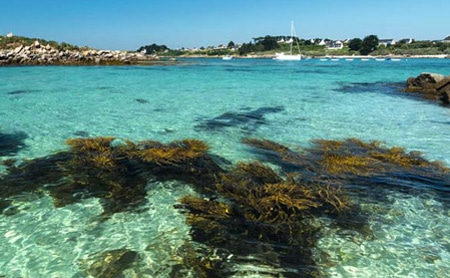If you think an island holiday has to mean a long-haul flight, think again. Nicki Grihault finds her sea legs and explores places closer to home

Fancy shell-hunting, rockpooling and building sandcastles on a Caribbean-like beach just a ferry ride away? Island- hopping, wildlife-watching and exploring? Islands easily accessible by ferry from our shores allow families to play Robinson Crusoe close to home. Ferry travel is both flexible and affordable – according to research in 2017 by money-saving blogger Lotty Earns, sponsored by Discover Ferries, a family of four can save more than 50% of their travel costs if they take a ferry rather than go on a fly-drive holiday.
Going by ferry means families can take their passions with them – which means not only the car, but the bikes, golf clubs, and the family dog. Getting there is part of the fun too, as modern ferries offer plenty to keep children busy, with play areas, film screenings, video games, live music, cabarets, DJs and quizzes, even swimming pools. It’s also about getting close to nature, with the chance to spot islands, seabirds and even dolphins from the deck. Family Traveller explores some of the most family-friendly islands that are easy to reach by ferry across Scotland, The Channel Islands, the Isles of Scilly, The Netherlands and France.
Wildlife-watching: Travelling by ferry is a great way to watch wildlife. Discover Ferries, which represents 11 ferry companies operating 75 routes from the UK and Ireland, has partnered with ORCA, a Portsmouth-based charity working to create safer habitats for cetaceans (whales, dolphins and porpoises).
This initiative encourages seafarers to identify and record sightings. From March-September, passengers on DFDS King Seaways from Newcastle to Amsterdam can join free deck watches with an ORCA wildlife officer. Condor Ferries support MARINElife, a Dorset-based charity. Children can join a MARINElife wildlife officer aboard Condor Liberation from Poole to Guernsey to spot whales, dolphins and seabirds (£22, including a donation).
Scotland has nearly 800 islands, many uninhabited, divided into island groups. With great beaches, ancient castles, wildlife including whales, puffins, eagles and dolphins, and walking, cycling and kayaking, they are wild and beautiful places offering action-packed family holidays. Island groups to choose from include Shetland and Orkney in the north, and the Hebrides off the west coast.
Skye is Scotland’s Jurassic Park, with some of the most dramatic natural landscapes in the world. The Sleat peninsula in the south where the ferry arrives has beaches, lochs, forests and glens, but the north is like Lord of the Rings, with the peaks and cliffs of Quiraing bearing names like The Needle and The Prison. It’s a place for walking, and a family favourite is the fairy pools at the foot of the Black Cuillins, with crystal-clear river water for wild swimming (in wetsuits!). Dinosaur-obsessed kids can search for footprints on the beach at An Corran at Staffin – whose museum has a tremendous collection of remains. Skye’s main town, Portree, has pretty pastel cottages on the harbour, and the island offers a wide variety of accommodation.
Getting there
CalMac operates a direct daily route from Mallaig (reached by road or train) in the west Highlands to Armadale on Skye, which takes 30 minutes. CalMac also operates passenger or car ferries from Mallaig to Eigg, Muck and Rum.
Price
Sample fare for a car plus 2 adults and 2 children with CalMac, Mallaig-Armadale: £35.60 return.
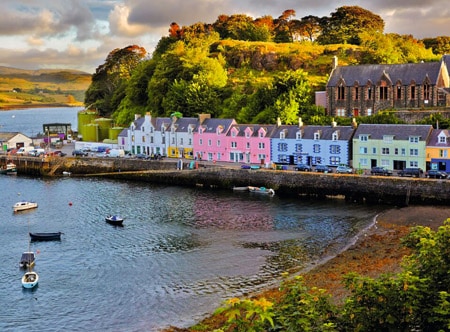
Mainland, one of 70 fragments of land that compose the Orkneys, is littered with ancient remains, many predating Stonehenge. Children can puzzle over the Ring of Brodgar Stone Circle and Henge, the largest stone circle in Scotland, see graffiti dragons carved by Vikings on the burial chamber walls at Maeshowe – those who dare to enter the Tomb of the Eagles, must do so lying flat on a trolley. Fireplaces, and even stone beds and dressers, of 5,000 years ago have been found at the Neolithic village Skara Brae. With little traffic on Mainland, youngsters are free to run wild.
There are beaches to play on, where they can hunt the lucky groatie buckie shell and spot seals; and at Fernvalley Wildlife Centre in Rendall they can see exotic rescue animals like African pygmy hedgehogs and raccoon dogs up close. Treats to try include creamy Orkney cheese, fudge and ice cream. Island-hopping in the Orkneys can include spotting puffins on Westray; a 14km circular cycle route for older kids on Rousay; and taking your bikes to Hoy, spotting sea eagles nesting in the hilltops, picnicking on Rackwick beach, and a walk to the Old Man of Hoy, which featured in Steven Spielberg film The BFG.

Getting there
NorthLink Ferries operates a 90-minutes direct route 1-3 times daily from Scrabster in the Northern Highlands to Stromness on Mainland. It also runs car ferries from Aberdeen to Kirkwall and Lerwick.
Price
Sample fare for a car plus 2 adults and 2 children with NorthLink Ferries: Scrabster- Stromness, £103.10 one way (cabins from £29).
Known as Scotland in Miniature, Arran has dramatic mountains, verdant forests, sheltered beaches and glens. Families can cycle around it in a day, or climb Goat Fell mountain – looming over Brodick Bay it’s the island’s highest at just over 873m – fuelled by local artisanal cheese with oatcakes. Abundant wildlife includes seal colonies, otters, golden eagles, basking sharks, porpoises and more than 100 bird species. Families can also explore its rich history, from the Bronze Age Machrie Moor Stone Circles to an underground prison, ‘the pit’, at Lochranza Castle.
Getting there
Caledonian MacBrayne operates a direct route from Ardrossan (reached by car/train from Glasgow in under an hour) to Brodick, which takes 55 minutes.
Price
Sample fare for a car plus 2 adults and 2 children, from £52.80 return.

This is Eagle Island, named after the golden and rare white-tailed sea eagles soaring above its 300 miles of dramatic coastline. Calgary Bay is one of Scotland’s finest beaches and the sea arches of Carsaig are impressive, but it’s best known for its wildlife which includes red deer, otters and seals. Kids may recognise the port of Tobermory, with its brightly painted houses, as the setting of CBeebies’ Balamory. Quiet, single-track roads are safe for cycling with youngsters; there’s also pony-trekking, and boat trips to Iona Abbey and the cathedral-like Fingal’s Cave on Staffa, a geological wonder.

Getting there
CalMac operates a 46-minute direct route from Oban to Craignure on Mull.
Price
Sample fare for a car plus 2 adults and 2 children with CalMac, Oban-Craignure: £46.80 return.
Often nicknamed ‘Bicycle Island’ (with bike hire at Millport), Cumbrae is a popular destination for sporty families, who can cycle the 10 mile flat route around its circumference, taking in beaches and spotting wildlife, such as owls, polecats, kestrels and sometimes sea eagles and basking sharks. Low tide reveals the painted Crocodile Rock in Millport Bay, for kids to sit on if they dare. A water sports centre offers yachting, dinghy sailing, windsurfing and powerboating as well as kayaks and stand-up paddleboards for hire to explore the bay, and there are guesthouses and holiday cottages to stay in.
Getting there
CalMac operates a direct route from Largs (reached by car from Glasgow in under an hour) to Cumbrae, a 10-minute journey. Booking not necessary.
Price
Sample fare for a car plus 2 adults and 2 children with CalMac: Largs-Cumbrae from £21.80 return.

You’ll find simplicity and sophistication with a French flavour here, plus oodles of family attractions and activities
Outside Guernsey’s picturesque capital of St Peter Port are 27 beautiful beaches, cycle routes along the coast, and ‘Tasty Walks’ with themes ranging from witches and castles to secret coves and rugged cliffs, plus fabulous food on the way. Also on the outdoor-activities menu is sea kayaking through watery caves, climbing, abseiling and coasteering down 300ft high cliffs, plus boat trips to spot seals, puffins and more. Family attractions include The Aquarium, newly renovated and with a tope shark, rays and conger eels in the Predator Pool, and a new 12-hole interactive Pirate Bay Adventure Golf with lurking pirates, erupting volcanos, shipwrecks and treasure.
From here, you can island-hop to the car-free sister isles of Herm, Sark and Alderney, all within an hour. Families can walk along coastal paths on Herm to swimming beaches, from the Caribbean-like white sands of Shell Beach, with kayaks and paddleboards for hire, to the pretty, sheltered Belvoir Bay. A Puffin Patrol by kayak (April-July) takes in breeding colonies around the island’s rocky shore. Stay in the stylish White House Hotel, a holiday cottage or go camping. Cycling around Sark includes a thrilling ride along Sark’s La Coupée, a stunning 80m-high narrow isthmus.
The island also has caves to explore, star-gazing and, for teens, coasteering on its wild, rocky shoreline and into Gouliot Caves, with their huge chambers and pools with sponges and anemones. Like the Gouliot caves, the west coast of Alderney is a Ramsar site, meaning it has internationally important wetlands. Historic forts and sandy beaches pepper 50 miles of coastal walking trails and in summer there’s a scenic train ride to Alderney lighthouse.

With the UK’s warmest weather, Jersey’s main draw are its unspoilt beaches, from waterfalls, rockpools and sea caves to explore at Plémont Beach, golden sands and watersports at St Brelade’s Bay, voted one of the UK’s top 10 beaches, and a safe tidal pool and lido at Havre des Pas, near the capital St Helier.
Safe cycle tracks lead through forested lanes fringed by wildflowers – and cafés serving delicious local seafood – with red squirrels to spot along the way). Family attractions range from Jersey Zoo, with its endangered species such as orangutans, lemurs and tamarins, and the aMaizin! adventure park, with go-karts, tractor rides and water pistol range, to the award-winning Maritime Museum.
Getting there
Condor Ferries operates routes from Portsmouth and Poole to Guernsey and Jersey, six days a week year-round, and daily from July to October. Its high-speed car ferry, Condor Liberation, takes 3-4.5 hours from Poole to Guernsey/Jersey, and the Commodore Clipper takes 8-10 hours from Portsmouth to Guernsey/Jersey, a slower but smoother crossing, with an overnight return.
Travel Trident operates a daily ferry to Herm, which takes 20 minutes. Sark Shipping operates daily to Sark, which takes 50 minutes. Manche Iles Express operates a service to Alderney via Dielette in France, taking about an hour.
Price
Sample fares for a car plus 2 adults and 2 children: Condor Ferries Poole/Portsmouth-Jersey/Guernsey, £172 each way if booked before 30 April for travel until 30 September 2018; cabins £39.95/£119.95 (day/night); Travel Trident Guernsey-Herm from £34 each way; Sark Shipping Guernsey-Sark, £77 return; Manche Iles Express Guernsey-Alderney from £108 return.
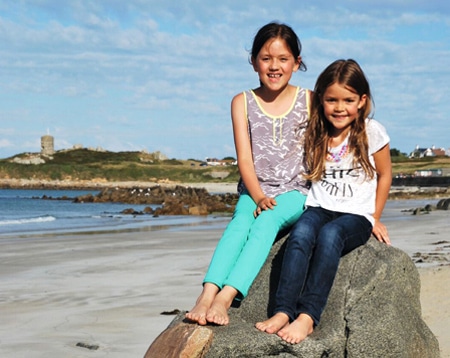
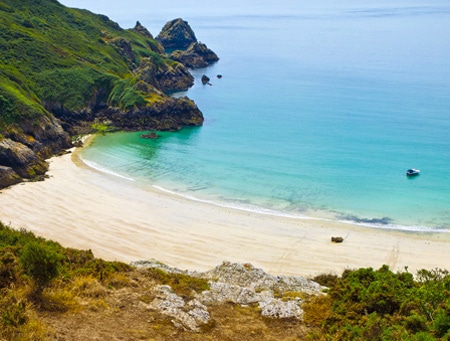
The UK’s largest archipelago has Caribbean-like beaches, wildlife walks and fresh local food – no wonder so many families have fallen for these tiny, safe, easygoing islands off the coast of Cornwall.
Five inhabited islands offer over 60 miles of trails and tracks, 35 beaches, and historic sites dating back to the Stone Age. Around 140 uninhabited islands provide a safe haven for wildlife and seabirds, and island-hopping is part of the fun, with the chance to spot puffins, seals, dolphins and rare birds. Accommodation options range from converted barns to castles, four-star hotels to self-catering and camping. St Mary’s is the ‘busiest’ of the islands, with the archipelago’s only museum, but away from Hugh Town are deserted stretches of blond beach and rocky coves, such as Porthloo Beach for rockpooling and Town Beach for beachcombing.
Hire a bike or golf cart to explore, or take the coastal paths and nature trails, and try outdoor activities including sailing, kayaking, windsurfing, horse-riding and coasteering. Although it’s just two miles long, laidback St Martin’s main draw is world-class beaches, such as Great Bay, with white sand and crystal-clear water for swimming, considered by many to be the best beach in the UK. Alongside rockpools and shell hunts, a highlight is snorkelling among playful Atlantic grey seals, and a dive school offers trips to the reefs and shipwrecks. For landlubbers, there’s coastal horse-riding and cycling.
Subtropical Tresco has dramatic rocky outcrops, Bronze Age burial sites and castle ruins, and secluded beaches, and Tresco Abbey Garden, with 20,000 exotic plants from all over the world. Families can explore walking trails in the rugged north, hire bikes, or take a boat or kayak from Tresco Sailing Club. Rugged and untamed Bryher has surf pounding one side but on the other are calm, sandy beaches, such as family-friendly Great Par, and the award-winning Hell Bay Hotel. The sandbar which, at low tide, separates the tiny, unspoilt island of St Agnes and it’s even smaller neighbour, Gugh, is a perfect sheltered spot for messing around in a dinghy.
Isles of Scilly Steamship Group operates a direct route on the Scillonian III passenger ferry from Penzance to St Mary’s daily from March to November, which takes 2hrs 45mins.
Inter-island transfers are arranged with local ferry/boat companies. St Mary’s Boatmen’s Association offers island-hopping and wildlife boat trips.
Family-friendly
Scillonian III offers reclining seats, a bar and café and baby-changing facilities. It’s not unusual to see a pod of dolphins playing in the ferry’s wake, and with seats on deck, kids can also spot basking sharks and ocean sunfish off the Cornish coast.
Price
Sample fares for two adults and two children with Isles of Scilly Steamship Group: Penzance to St Marys from £149 each way; return fares to any island with St Mary’s Boatmen Association: from £28.50 per family of four (there’s a discount for two islands or more).
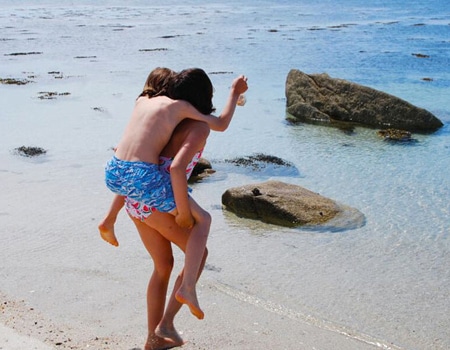
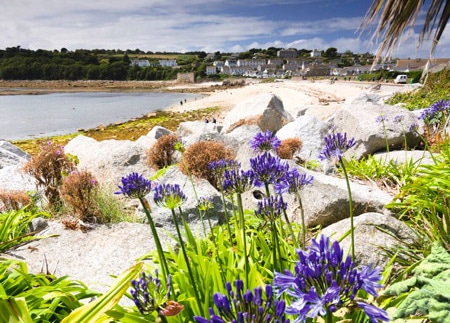
Rolling dunes, sea grass meadows and endless sandy beaches…
The Frisian, or Wadden Islands, a North Sea archipelago, offer a pristine wilderness just a few hours from Amsterdam, and a full range of accommodation options. Terschelling has more than 70km of cycleways through moorlands, mudflats, marshes and forests, sand dunes in the south and is home to the largest variety of butterflies and birds in the country. The largest island, Texel, has magnificent long beaches stretching to its lighthouse and Texel National Park, one of Holland’s most extraordinary landscapes, of sand dunes, forests, heath and beach with the chance to spot seals (guaranteed at the seal and porpoise sanctuary), birds and reptiles. Car-free Vlieland, a grass-covered dunescape, is the smallest of the inhabited islands here, and popular with youngsters.
Getting there
Stena Line offers 7-hour crossings (day and overnight) on luxurious superferries Britannica and Hollandica, between Harwich and the Hook of Holland. DFDS operates a daily overnight crossing from Newcastle to Amsterdam. A 2-hour crossing (or 45-minute fast ferry) by Doeksen sails several times a day between Harlingen and Terschelling.
Family-friendly
Stena Line has restaurants and bars, a plush lounge, cinema, and even a basketball court. Family cabins sleep up to five, with en suites, TV and wifi. ‘Happy at Sea’, a new initiative for families, features Happy the Dolphin in the children’s play area. DFDS has restaurants, bars and shops, a cinema and Kidz’ Club with ball pit, a children’s entertainer, games room and an ORCA Wildlife Lounge where families can learn about aquatic wildlife.
Price
Sample fare for a car plus 2 adults and 2 children with Stena Line: Harwich-Hook of Holland from £184 (£252 with overnight family cabin) return. With DFDS: Newcastle-Amsterdam from £160 return, with cabin.


With hidden coves, pebble beaches and tropical landscapes, The Breton Islands are hidden gems
A 10-minute boat ride from the coast of Paimpol, Île Bréhat is the loveliest. It’s actually two small, car-free islands joined by a bridge at low tide, and surrounded by several more small islets. A microclimate means it boasts palm trees, while puffins nest in its pink rocks. It’s a place to cycle, and coastal walks in the wilder north pass rolling moorland, rocky outcrops, and its two lighthouses. Places to stay include a campsite. As the entrance to the English Channel, the rugged and dramatic Île d’Ouessant, 30km off the coast, has six lighthouses, including Créac’h, which has one of the most powerful beams in the world.
Evidence of its treacherous seafaring heritage can be seen in its cemeteries full of unknown sailors and lists of lost ships. As well as 400 bird species, it has its own breed of small black sheep. A 15-minute boat ride from Roscoff, the tiny, almost car-free Île de Batz ticks all the boxes: sheltered white sands at Grève Blanche, cycle routes linking all the beaches in minutes, and an eight-mile coastal walking trail, with great views from the top of the lighthouse. It also has pony rides, a watersports centre and botanical garden. Places to stay include a hostel and campsite, and there are a few eateries and shops.
Getting there
Brittany Ferries runs daily ferries between Plymouth and Roscoff, the closest port to the islands (6-8 hours), and Portsmouth to St Malo (9-11 hours).
Price
Sample fare for a car plus 2 adults and 2 children with Brittany Ferries: Plymouth-Roscoff from £318 return.
